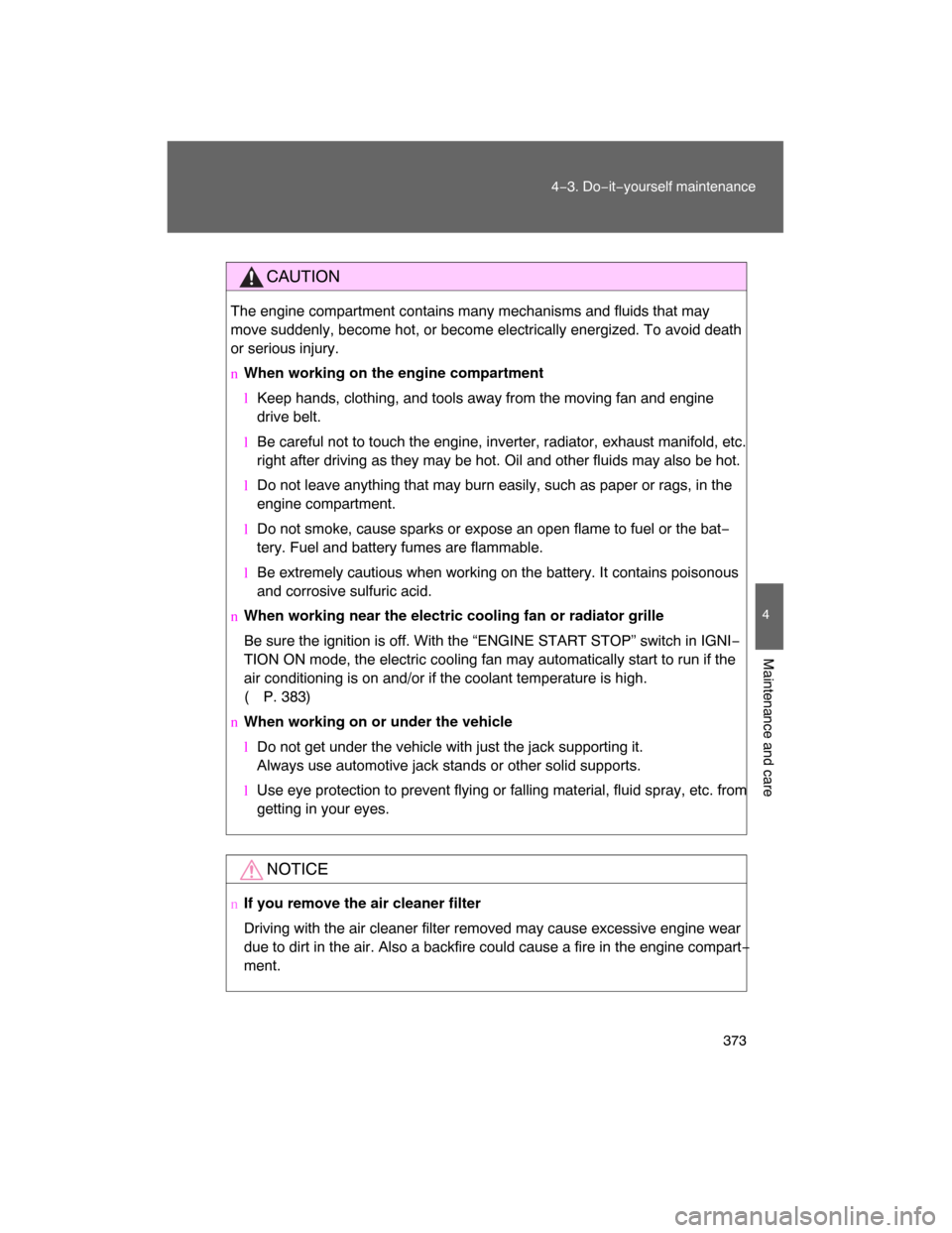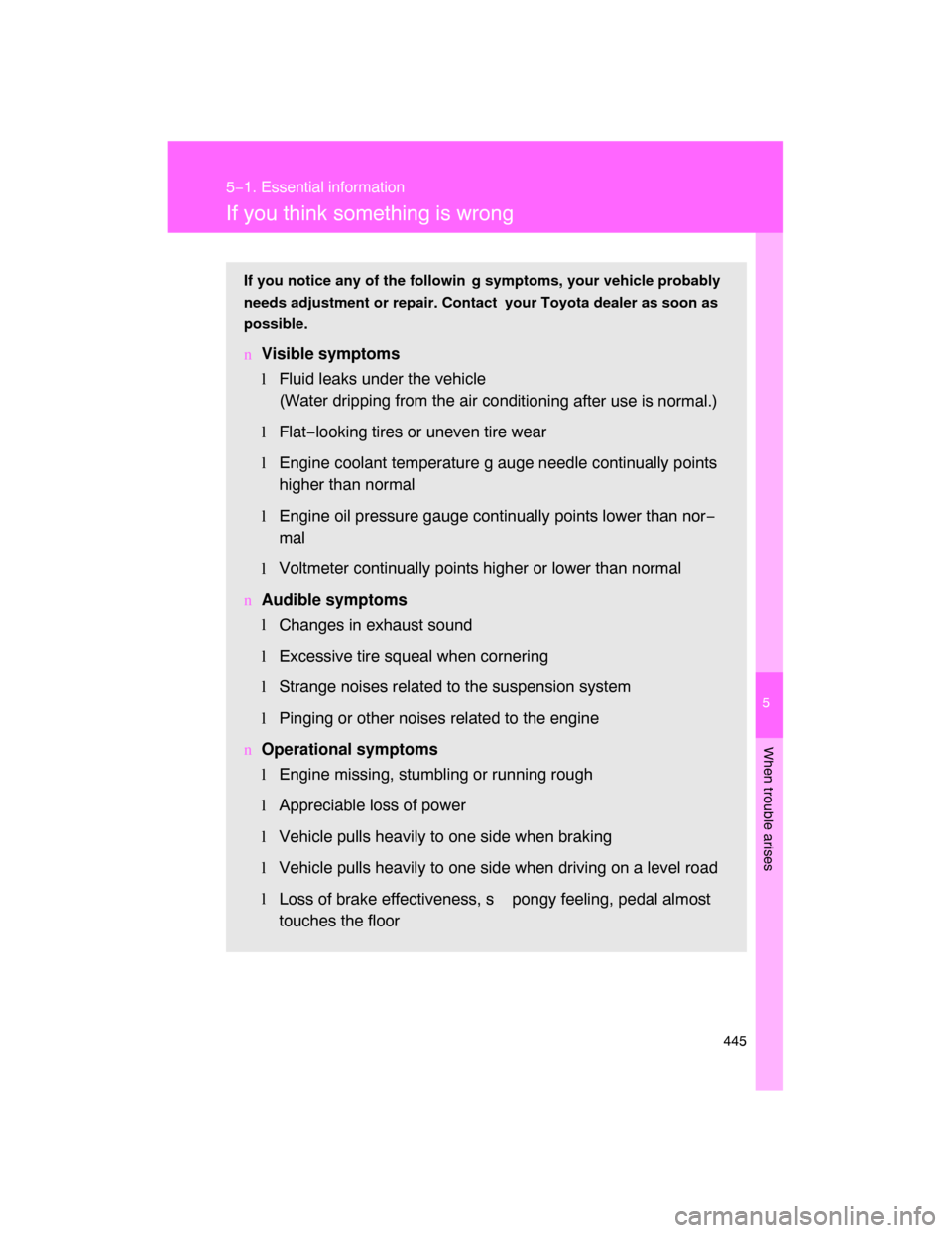Page 160 of 531
162 2−2. Instrument cluster
NOTICE
nTo prevent damage to the engine and its components
lDo not let the indicator needle of the tachometer enter the red zone, which
indicates the maximum engine speed.
lThe engine may be overheating if the engine coolant temperature gauge is
in the red zone (“H”). In this case, immediately stop the vehicle in a safe
place, and check the engine after it has cooled completely. (
P. 488)
nWhile driving
lWhen the voltmeter indicates more than 19 V or less than 9 V, the battery
may be malfunctioning. Have your vehicle checked at your Toyota dealer.
l
When the engine oil pressure gauge does not work properly, immediately
stop the engine and contact your Toyota dealer.
Page 287 of 531
291
3−3. Using the rear seat entertainment system
3
Interior features
NOTICE
nCleaning the display
Wipe the display with a dry soft cloth.
If the screen is wiped with a rough cloth, the surface of the screen may be
scratched.
nTo prevent damage to the remote control
lKeep the remote control away from direct sunlight, high temperature and
high humidity.
lDo not drop or knock the remote control against hard objects.
lDo not sit on or place heavy objects on the remote control.
nDVD player
Never try to disassemble or oil any part of the DVD player. Do not insert any−
thing other than a disc into the slot.
nClosing the display
Do not close the display using your hand. Doing so may result in a malfunc−
tion.
Page 368 of 531

373
4−3. Do−it−yourself maintenance
4
Maintenance and care
CAUTION
The engine compartment contains many mechanisms and fluids that may
move suddenly, become hot, or become electrically energized. To avoid death
or serious injury.
nWhen working on the engine compartment
lKeep hands, clothing, and tools away from the moving fan and engine
drive belt.
lBe careful not to touch the engine, inverter, radiator, exhaust manifold, etc.
right after driving as they may be hot. Oil and other fluids may also be hot.
lDo not leave anything that may burn easily, such as paper or rags, in the
engine compartment.
lDo not smoke, cause sparks or expose an open flame to fuel or the bat−
tery. Fuel and battery fumes are flammable.
lBe extremely cautious when working on the battery. It contains poisonous
and corrosive sulfuric acid.
nWhen working near the electric cooling fan or radiator grille
Be sure the ignition is off. With the “ENGINE START STOP” switch in IGNI−
TION ON mode, the electric cooling fan may automatically start to run if the
air conditioning is on and/or if the coolant temperature is high.
(P. 383)
nWhen working on or under the vehicle
lDo not get under the vehicle with just the jack supporting it.
Always use automotive jack stands or other solid supports.
lUse eye protection to prevent flying or falling material, fluid spray, etc. from
getting in your eyes.
NOTICE
nIf you remove the air cleaner filter
Driving with the air cleaner filter removed may cause excessive engine wear
due to dirt in the air. Also a backfire could cause a fire in the engine compart−
ment.
Page 372 of 531
377
4−3. Do−it−yourself maintenance
4
Maintenance and care
Engine oil
With the engine at operating temperature and turned off, check the oil
level on the dipstick.
nChecking the engine oil
Park the vehicle on level gro und. After turning off the engine,
wait a few minutes for the oil
to drain back into the bottom of
the engine.
Hold a rag under the end and
pull the dipstick out.
Wipe the dipstick clean.
Reinsert the dipstick fully.
Holding a rag under the end, pull the dipstick out and check
the oil level.
Wipe the dipstick and reinsert it fully.
Low
Full
STEP1
ITY43C006
STEP2
STEP 3
STEP 4
STEP 5
STEP6
Page 374 of 531
379
4−3. Do−it−yourself maintenance
4
Maintenance and care
nRecommended viscosity
SAE 5W−20 or 0W−2 0 engine oil
may be used. However, SAE
0W−20 is the best choice for
good fuel economy and good
starting in cold weather.
nHow to read oil container labels
The ILSAC (International Lubricant Standardization and Approval
Committee) Certification Mark is added to some oil containers to
help you select the
oil you should use.
Outside temperature
Page 439 of 531

5
When trouble arises
445
5−1. Essential information
If you think something is wrong
If you notice any of the followin g symptoms, your vehicle probably
needs adjustment or repair. Contact your Toyota dealer as soon as
possible.
nVisible symptoms
lFluid leaks under the vehicle
(Water dripping from the air cond
itioning after use is normal.)
lFlat−looking tires or uneven tire wear
lEngine coolant temperature g auge needle continually points
higher than normal
lEngine oil pressure gauge continually points lower than nor−
mal
lVoltmeter continually points higher or lower than normal
n
Audible symptoms
l
Changes in exhaust sound
lExcessive tire squeal when cornering
l
Strange noises related to the suspension system
l
Pinging or other noises related to the engine
nOperational symptoms
l
Engine missing, stumbling or running rough
l
Appreciable loss of power
lVehicle pulls heavily to one side when braking
l
Vehicle pulls heavily to one side when driving on a level road
l
Loss of brake effectiveness, s pongy feeling, pedal almost
touches the floor
Page 490 of 531
497
6−1. Specifications
6
Vehicle specifications
Lubrication system
Oil viscosity:
l
The 0W portion of the oil viscosity rating indicates the characteristic
of the oil which allows cold startab ility. Oils with a lower value before
the W allow for easier starting of the engine in cold weather.
lThe 20 in 0W−20 indicates the oil viscosity when the oil is as its oper−
ating temperature. An oil with a higher viscosity may be better suited
if the vehicle is operated at high
speeds, or under extreme load con−
dition.
Oil capacity drain and
refill
(Reference)
with filter
without filter7.4 qt. (7.0 L, 6.2 lmp.qt.)
7.0 qt. (6.6 L, 5.8 lmp.qt.)
Oil grade
ILSAC multigrade engine oil
Recommended oil
viscosity
Use Toyota approved “Toyota Genuine Motor Oil”
or equivalent to satisfy the above grade and vis−
cosity.
Outside temperature
Page 505 of 531

512 6−1. Specifications
Warning: The temperature grades for this tire are established for a
tire that is properly inflated and not overloaded.
Excessive speed, underinflation, or
excessive loading, either sepa−
rately or in combination, can cause heat buildup and possible tire fail−
ure.
Glossary of tire terminology
Tire related term Meaning
Cold tire inflation
pressureTire pressure when the vehicle has been
parked for three hours or more, or has not
been driven more than 1 mile or 1.5 km under
that condition
Maximum inflation
pressureThe maximum cold inflated pressure to which a
tire may be inflated, shown on the sidewall of
the tire
Recommended
inflation pressureCold tire inflation pressure recommended by a
manufacturer.
Accessory weightThe combined weight (in excess of those stan−
dard items which may be replaced) of trans−
mission, power steering, power brakes, power
windows, power seats, radio and heater, to the
extent that these items are available as factory−
installed equipment (whether installed or not)
Curb weightThe weight of a motor vehicle with standard
equipment, including the maximum capacity of
fuel, oil and coolant, and if so equipped, air
conditioning and additional weight optional
engine
Maximum loaded
vehicle weight
The sum of:
(a) Curb weight
(b) Accessory weight
(c) Vehicle capacity weight
(d) Production options weight